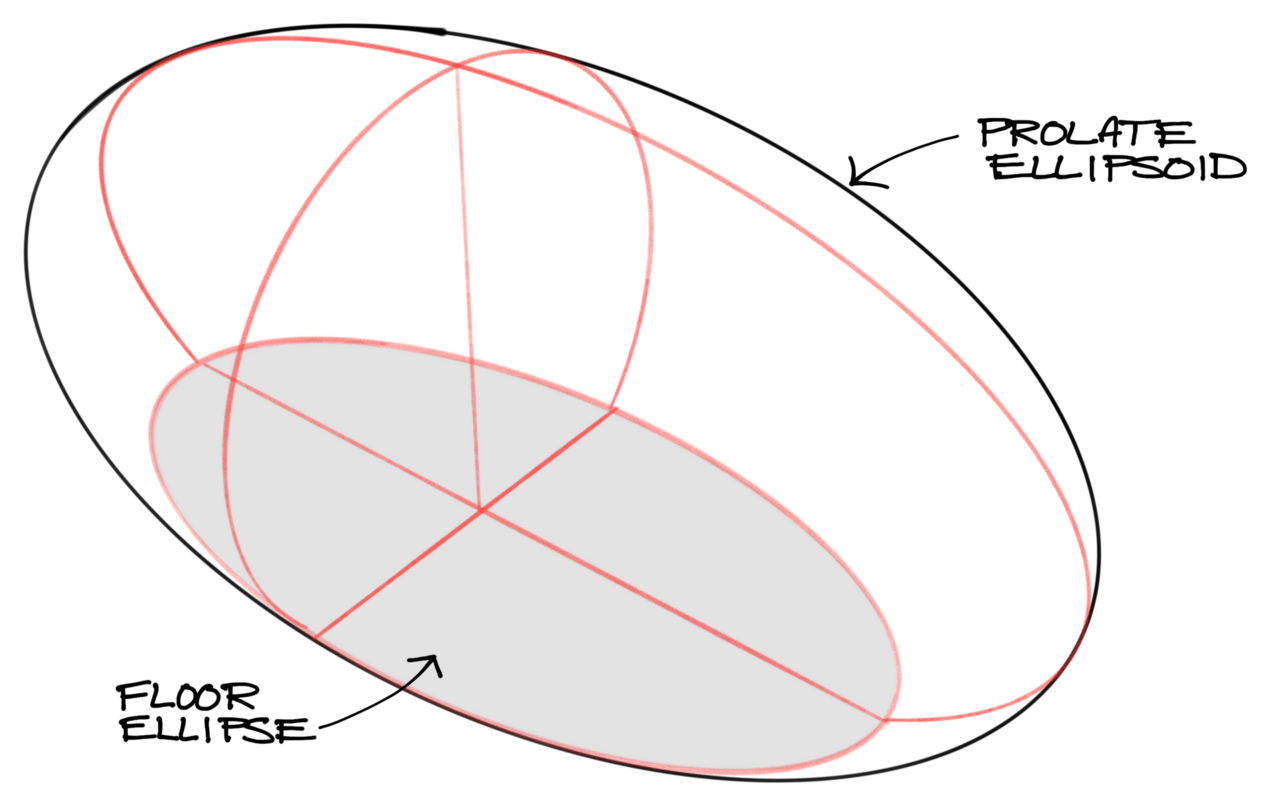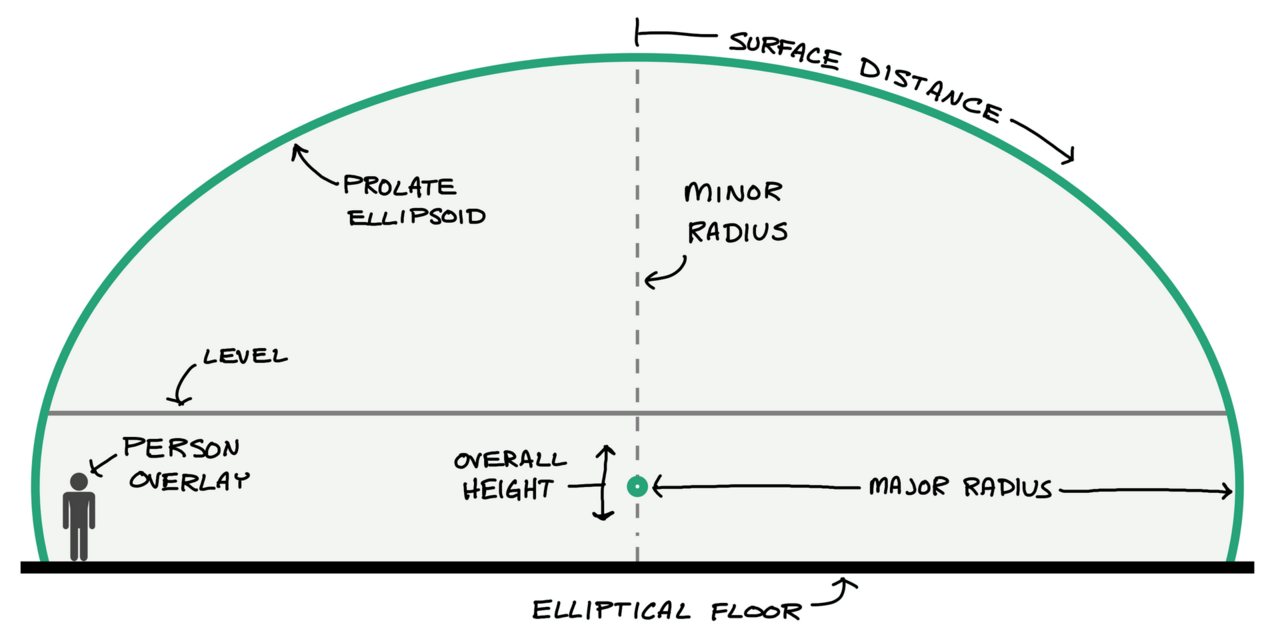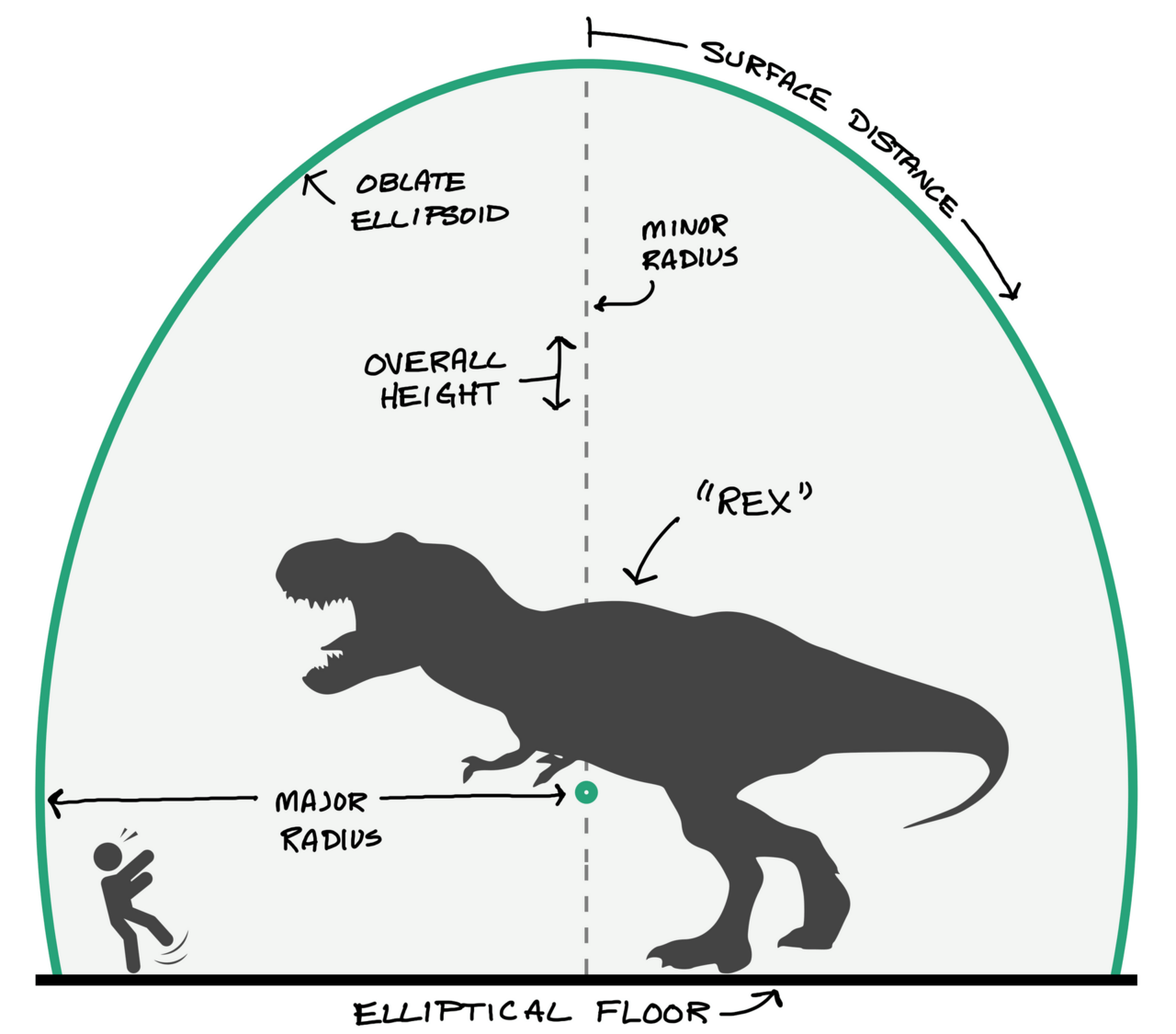Horizontal Ellipsoid Dome Calculator
Using the Horizontal Ellipsoid Dome Calculator
A horizontal ellipsoid looks like a watermelon sliced lengthwise and laid horizontally on the ground. The base forms an ellipse, while the cross-sections are an elliptical arc and a circular arc. This unusual shape is less common in dome construction but still useful. For example, squeezing a dome onto a narrow piece of land or expanding the “sides” of the dome for a better view.
There are no easy formulas for intersecting a horizontal ellipsoid with the ground. The Horizontal Ellipsoid Dome Calculator iterates over 72,000 segments to approximate the ellipsoid’s perimeters, distances, areas, and volume. The result is about 4 to 6 significant digits of accuracy.
All parameters are stored in the page URL, which may be bookmarked, saved, and shared. Use “Copy to Clipboard” to copy-and-paste results into your notes or emails. Print page or save as PDF for a professional copy of the drawing and results. Be aware that just because the calculator can draw a structure, it does NOT mean the structure can be built. This calculator is just a tool. Always consult with qualified professionals before proceeding with a project.
This calculator is subject to our Terms of Service.

Horizontal ellipsoids—also called spheroids—have an elliptical floor and an elliptical cross-section on one axis. The second axis always forms a circular cross-section. The most common shape is a prolate ellipsoid with a long major axis, a shorter minor axis, and the floor below the beltline.
Inputs
Major. The major radius or diameter measured from the ellipsoid or floor center.
Minor. The minor radius or diameter measured perpendicular to the major axis from the ellipsoid or floor center.
Object. The object being measured. If it’s an ellipsoid, all measurements are from the ellipsoid coordinate center with the major axis (a) horizontal to the ground and the minor axis (b) vertical to the ground. If it’s the floor, all measurements are of the elliptical floor with the major axis (a) and minor axis (b) projected onto the floor.
Measure. Determines if the major and minor inputs are half or full-length distances. Commonly ellipsoid measures are radii, while floor measures are often expressed as diameters.
Height. Overall height is always the distance measured vertically from the floor to the apex.
Level. The optional horizontal level above the floor—forming a subsection of the structure. It calculates an imaginary ellipse at that level plus the upper portion of the structure from that level to the apex. The level helps calculate the second floor.
Overlay. A scaled, graphical overlay to visually represent the building size and purpose.
Units. The selectable unit will label the calculator outputs and properly scale the overlay. Note that all numerical inputs must be given in the same selected unit.
Floor Ellipse
Major Diameter. The calculated major axis of the floor ellipse.
Minor Diameter. The calculated minor axis of the floor ellipse.
Perimeter. The distance around the ellipse-shaped floor.
Area. The area of the floor ellipse.
Foci. The distance from the floor center point along the major axis in both directions to the ellipse focal points.
Note: Click “Go to floor ellipse” to open these measurements in the MDI Ellipse Calculator.
Prolate or Oblate Dome
The dome shape is determined by the ratio of major/minor inputs. For a prolate ellipsoid, the major distance is greater than the minor distance. For an oblate ellipsoid, the major distance is less than the minor distance.
Major Radius. The horizontal distance from the coordinate center to the ellipsoid side.
Minor Radius. The vertical distance from the coordinate center to the ellipsoid apex.
Overall Height. The vertical distance from the floor to the ellipsoid apex.
Ellipticity Ratio. The ratio between the horizontal and vertical radii describing the centerline ellipse.
Surface Distance. The distance from the apex—following the elliptical curve—to the floor.
Surface Area. The overall lateral surface area from the floor to the apex.
Volume. The cubic measure of the volume encompassed by the ellipsoid.

The Eye of the Storm beach house is a large horizontal prolate ellipsoid 80-feet wide (major diameter), 57-feet deep (minor diameter), and 34-feet tall (height). The broader “sides” of the prolate shape expand the deck and ocean view from the home. Click for the live version of this design.
Level @
Height Above Floor. The level height is the distance from the floor to a horizontal “slice” at the level specified above the floor, and it effectively creates a subsection of the overall building.
Major Diameter. The calculated major axis of the ellipse at the specified level above the floor.
Minor Diameter. The calculated minor axis of the ellipse at the specified level above the floor.
Perimeter. The perimeter around the ellipse at the specified level above the floor.
Area. The area of the ellipse at the specified level above the floor. Typical use is to set the level at 10-feet (3 m) to calculate the second floor’s size and area.
Portion Above Level
Remaining Height. The imaginary slice through the structure at the specified level essentially creates a second portion of the overall structure. The remaining height is calculated as the height from the specified level to the dome’s apex.
Surface Distance. The surface distance is the length from the apex, following the elliptical curve down to the imaginary slice at the specified level.
Surface Area. The level surface area is the remaining structure’s overall surface area above the imaginary slice at the specified level.
Volume. The level volume is the total cubic volume encompassing the remaining structure above the specified level.

Our mythical T-Rex enclosure is an oblate ellipsoid—kind of like a plain M&M tipped on its edge—where the major axis (24-feet) is smaller than the minor axis (32-feet). At 40-feet tall, the calculated cross-section shows a tall elliptical dome that is deeper than it is wide. Click for the live version of this design.
Overlays
An overlay is a scaled illustration to help convey the calculated structure’s size, purpose, and scope. The overlays are for convenience only, and no attempt is made to “fit” them inside the building or determine their appropriate use for a structure.
None. The none option deletes the overlay.
Person. The person overlay is the default overlay. It is a person rendered at 6-feet (1.8 m) tall.
Car. The car overlay is a mid-sized sedan with a 6-foot (1.8 m) person standing beside it.
BBall. The bball overlay is the side silhouette of a standard American competition basketball court on a six-inch floor. We recommend setting the level parameter to 20.5 feet to show the standard clearance height required for a competition floor.
Loader. The loader overlay is a small front-end loader—6,000 pounds (2800 kg) operating capacity with bucket—approximately 8 feet (2.5 m) tall next to a 6-foot (1.8 m) tall person.
Heavy. The heavy overlay is a large front-end loader—66,000 pounds (30,000 kg) operating weight—approximately 12.5 feet (3.8 m) tall next to a 6-foot (1.8 m) tall person.

The top portion of a storm shelters in Tupelo, Missouri, is a partial prolate ellipsoid constructed on an elliptical concrete block stem wall. By modifying the footprint from a circle to an ellipse, they could squeeze the storm shelter onto the available land. The base dimensions are 101-feet major diameter, 81-feet minor diameter, by 20.5-feet tall. The calculator extrapolated the overall ellipsoid shape from the base dimensions. Click for the live version of this design.